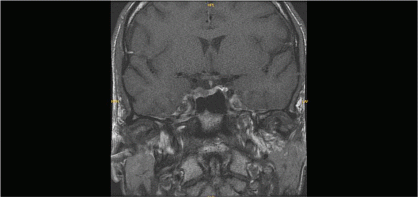ECE2022 Poster Presentations Late-Breaking (41 abstracts)
A patient with acromegalic heart disease
Mehdi Houssein 1 , Kubra Turan 1 , Ahmet Temizhan 2 , Belma Tural Balsak 1 , Abbas Ali Tam 1 , Oya Topaloglu 1 , Reyhan Ersoy 1 & Bekir Cakir 1
1Ankara City Hospital, Department of Endocrine and Metabolic Diseases, Ankara, Turkey; 2Ankara City Hospital, Department of Cardiology, Ankara, Turkey
A 36 years of old patient was admitted to the intensive care unit of cardiology when he experienced palpitations and orthopnea. The patient’s complaints started about 2 years ago as syncope and sudden shortness of breath. Thorax CT showed pleural effusion and increased cardiothoracic index. Findings on ECHO were : Ejection fraction 35%, severe mitral regurgitation and global hypokinesia. Coronary angiogram showed a fibrocalcific plaque noted in in the distal LAD. The patient was started on Furossemide, spironolactone, isosorbide mononitrate. Despite the treatment, the patient’s complaints gradually increased and over the course of the next 24 months, the patient was repeatedly hospitalised due to heart failure, and his medication was adjusted several times. Two years later, the patient was admitted to our center with the diagnosis of acute heart failure. A decrease in ejection fraction was detected in the new echocardiography (%10), and no further clinical improvement was seen, the decision was then taken to initiate treatment with levosimendan and noroadrenaline. Dilated cardiomyopathy was observed with cardiac MRI. He was consulted to the endocrine departement because of suspected acromegaly. When he was evaluated, he complained of shortness of breath, arthralgia and increasing shoe size. Physical examination was positive for acral growth, nose widening, and prognathism. GH and IGF-1 levels were increased at diagnosis (table 1), the baseline and peak GH concentrations were 8.74 and 34.4 ng/ml during 75-g OGTT, showing paradoxical increases in GH (table 2). Pituitary MRI showed a non-invasive, intrasellar, macroadenoma (fig1). The diagnosis made was: Acromegaly due to growth hormone secreting pituitary macroadenoma leading to dilated cardiomyopathy. His family history was negative, but due to his young age and aggressive clinical course, the patient was screened for AIP gene mutation; a germline AIP mutation was not identified. TSS was scheduled, and primary medical treatment with sandostatin lar 20 to improve the patient′s condition. However, the patient developed cardiogenic shock and unfortunately before surgery and before assessment of response to therapy.
| Hba1c (%) | 6.4 |
| P (mg/dl) (2.4-5.1) | 5.3 |
| Cortisol (μg/dl) | 10.6 |
| ACTH (pg/ml) (Sabah 07:00-09:00 <46) | 50.2 |
| Testosterone (ng/dl) (164-783) | 130 |
| FSH (mIU/ml) | 6.4 |
| LH (mIU/ml) | 5.6 |
| PRL (ng/ml) | 17.7 |
| GH (ng/ml) (0.05-3) | 25 |
| IGF-1 (ng/ml) (75-212) | 359 |
| Minute | 0. | 30. | 60. | 90. | 120. |
| Glucose | 80 | 112 | 162 | 198 | 173 |
| GH | 8.74 | 10.4 | 34.4 | 20.9 | 14.3 |
 }
}



